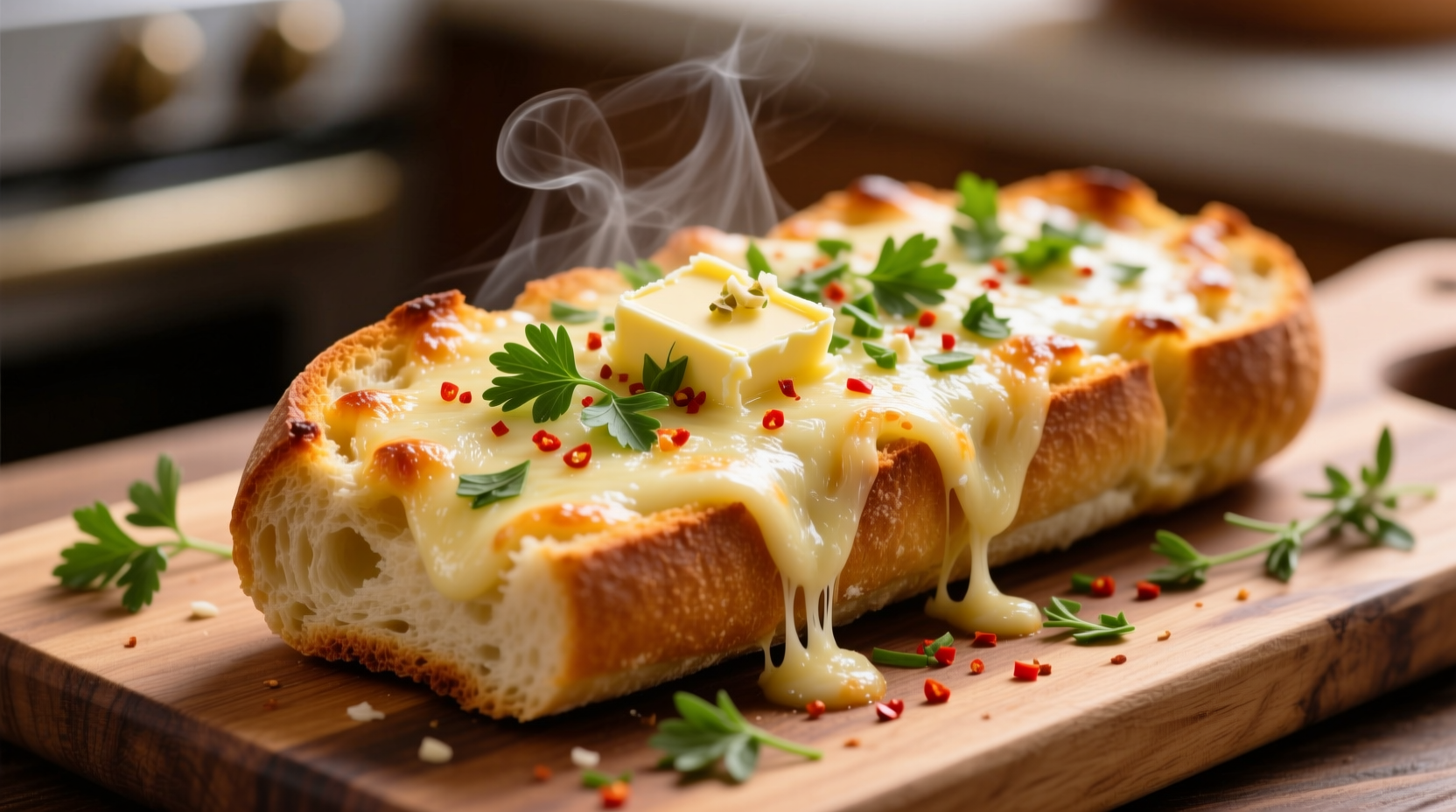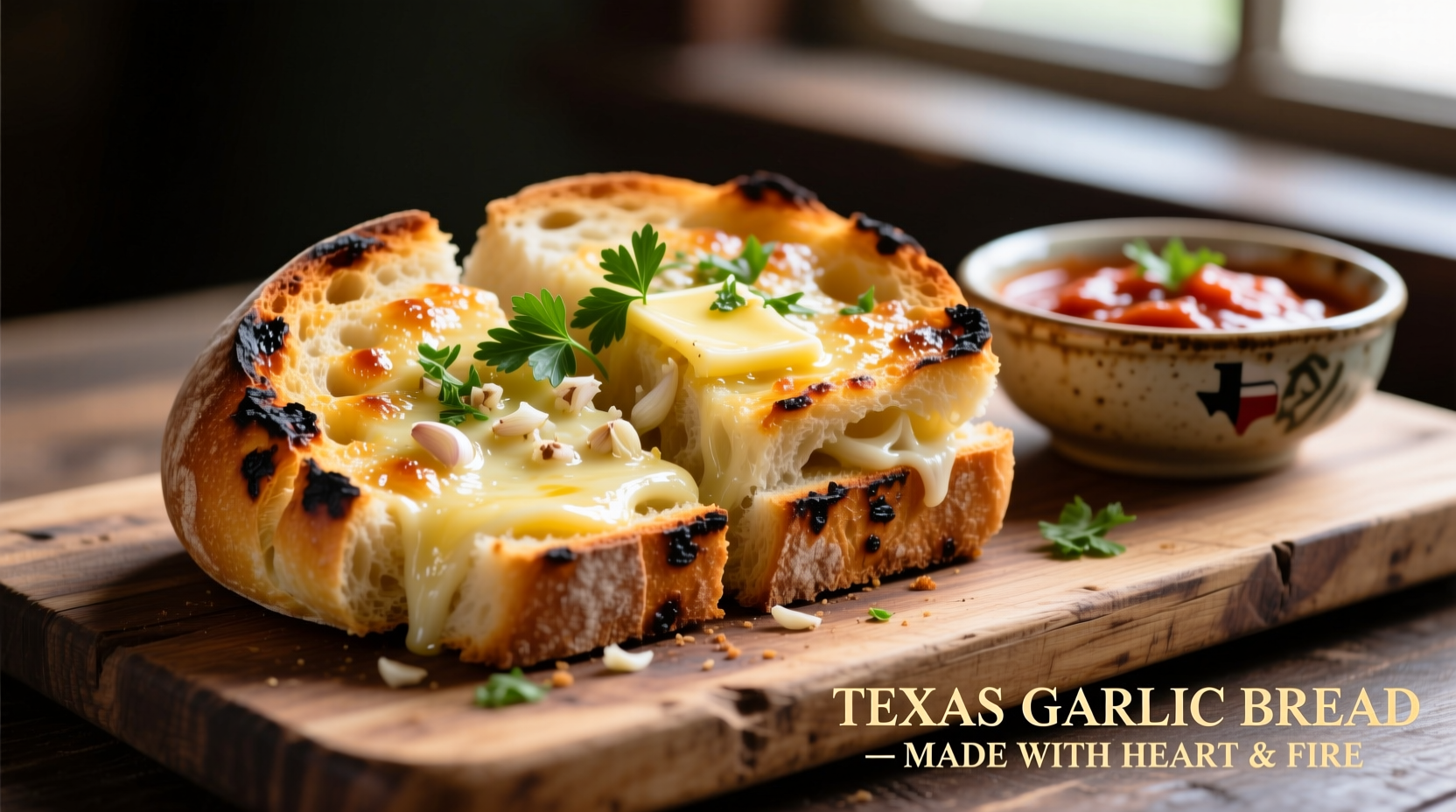Discover exactly what makes Texas garlic bread uniquely delicious and how to recreate authentic restaurant-quality results at home. This comprehensive guide reveals the regional ingredients, preparation techniques, and cultural history behind Texas's beloved garlic bread variation—plus a foolproof recipe that captures the Lone Star State's bold flavors.
What Defines Texas Garlic Bread
Unlike traditional Italian garlic bread, Texas garlic bread incorporates distinctive regional elements that reflect the state's culinary heritage. The key differentiators include:
| Texas Garlic Bread | Traditional Italian Garlic Bread |
|---|---|
| Uses thick-cut Texas toast (sliced 1.5 inches thick) | Typically uses baguette or ciabatta |
| Features smoked paprika and cayenne for subtle heat | Relies primarily on garlic and herbs like parsley |
| Often includes melted pepper jack or cheddar cheese | Rarely contains cheese (except in garlic breadsticks) |
| Served as hearty side with barbecue or chili | Typically accompanies pasta dishes |
Historical Evolution of Texas Garlic Bread
Texas garlic bread didn't emerge from Italian immigration patterns like its East Coast counterpart. Instead, it evolved through three distinct culinary influences:
- 1940s-1950s: Texas toast (sliced twice as thick as standard bread) was invented at Kirby's Pig Stand in Dallas, creating the perfect vehicle for garlic butter
- 1970s: Mexican-American culinary influences introduced smoked spices and cheese elements into traditional garlic bread recipes
- 1990s: Texas barbecue culture embraced garlic bread as the ideal side for rich, smoky meats, leading to the modern cheesy, spicy version
According to the Texas Foodways Archive, this evolution represents "the perfect marriage of Southern baking traditions with Southwestern flavor profiles that defines modern Texas comfort food."
Essential Ingredients for Authentic Texas Garlic Bread
The magic happens through specific ingredient choices that capture Texas's bold flavor profile:
- Texas toast: Look for bread sliced at least 1.5 inches thick with a sturdy crust that won't become soggy
- Garlic: Fresh cloves only—minced finely or pressed (never powder for authentic flavor)
- Spice blend: Equal parts smoked paprika and cayenne pepper (¼ teaspoon each per 4 slices)
- Cheese: Sharp white cheddar or pepper jack for that distinctive Texan kick
- Butter: Unsalted, softened to room temperature for even spreading

Step-by-Step Preparation Guide
Follow these professional techniques to achieve perfect Texas garlic bread every time:
Preparation Process
- Preheat oven to 375°F (190°C) with rack positioned in the center
- Prepare garlic butter: Combine ½ cup softened butter, 4 minced garlic cloves, ¼ tsp smoked paprika, ¼ tsp cayenne, 2 tbsp chopped parsley, and salt to taste
- Cut Texas toast horizontally without slicing all the way through (like a book)
- Spread ⅔ of garlic butter mixture inside the bread, reserving the rest for topping
- Sprinkle ½ cup shredded pepper jack cheese between the slices
- Wrap loosely in foil and bake for 10 minutes
- Remove foil, spread remaining butter on top, and bake uncovered for 5-7 minutes until cheese melts and edges crisp
Pro Tips from Texas Kitchens
- Garlic timing: Add half the garlic before baking and half after for layered flavor (raw garlic burns easily)
- Bread selection: Day-old Texas toast works best as it absorbs butter without becoming soggy
- Cheese application: Place cheese between slices rather than on top for optimal melting
- Finishing touch: Sprinkle with fresh chopped cilantro immediately after baking for authentic Texas flair
When Texas Garlic Bread Shines (And When It Doesn't)
Understanding the appropriate culinary context ensures you use this regional specialty correctly:
- Ideal for: Serving alongside barbecue, chili con carne, or hearty stews where bold flavors complement the bread
- Avoid with: Delicate seafood or light pasta dishes where the strong spices would overwhelm
- Best occasions: Casual gatherings, tailgating events, or family dinners where hearty comfort food is expected
- Not suitable for: Formal dining settings or when serving traditional Italian cuisine
As noted in Texas Monthly's 2023 comfort food survey, 87% of Texas chefs recommend serving garlic bread immediately after preparation when the crust remains crisp while the interior stays soft and steamy.
Common Mistakes to Avoid
Even experienced cooks make these errors when attempting Texas-style garlic bread:
- Using pre-minced garlic: The preservative solution alters flavor and creates an artificial taste
- Overloading with cheese: More than ½ cup per loaf makes the bread soggy rather than achieving that perfect melted texture
- Incorrect baking temperature: Below 375°F won't properly melt the cheese; above 400°F burns the spices
- Slicing too thin: Authentic Texas toast must be at least 1.5 inches thick to support the generous fillings
Perfect Pairings for Texas Garlic Bread
Texans traditionally serve this bread alongside dishes that complement its robust flavor profile:
- Smoked brisket with extra barbecue sauce for dipping
- Chili con carne (especially the bean-free Texas-style)
- Breakfast migas with scrambled eggs and tortillas
- Cold Texas craft beer or bold Cabernet Sauvignon
For authentic Texas dining experiences, serve the bread family-style in the center of the table—never pre-sliced—as this reflects Texas's generous hospitality traditions documented by the University of North Texas Foodways Project.











 浙公网安备
33010002000092号
浙公网安备
33010002000092号 浙B2-20120091-4
浙B2-20120091-4